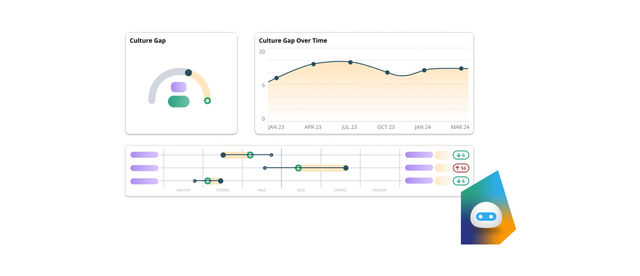A thriving company culture is not just a feel-good factor, but a critical driver of innovation and high-performing teams. Nevertheless, whilst most organisations are aware of culture’s vital importance, many still only rely on engagement questionnaires to gauge their current cultural performance, leaving them misinformed and falling behind the competition. The cultivation of high-performing teams can only be achieved by measuring behaviours and leveraging tangible, objective cultural data, used to refine, enhance and continually assess.
The benefits of strong company culture
It is widely accepted that engagement is an outcome of an aligned culture, and according to a Denison Consulting study, organisations with a strong culture benefit from 72% higher employee engagement, with mission-driven companies experiencing 40% higher retention levels, according to Deloitte. Furthermore, in its “Culture vs. engagement strategy” paper, the consulting company confirms that this engagement then translates to higher company loyalty and productivity, allowing culture-conscious companies to create high-performing teams and outperform the competition by 147%.
The new gold standard
In order to achieve this mission-driven status, however, companies must become much more intentional with their cultural data. In other words, they have to move discussions beyond gut feelings, anecdotal evidence and vague culture statements.
Organisations must measure cultural data, as it offers a clear, unbiased view of the current state of behaviours that exist daily and is crucial to understanding strengths and pinpointing areas for improvement. Then current data can be measured against an organisations target culture, to ensure the right actions are being taken to achieve the goals set. For example, if your organisation wants to build high performing teams, they may diagnose their current behaviours, and then set a target to be more decisive and less parental in how they get work done.
Critical steps for shaping high-performance teams
Leaders must begin by diagnosing their current culture and collating data from various sources, which may include anything from turnover rates to the outcomes of exit interviews and performance reviews. Culture15 can make this process easier, by turning qualitative feedback into quantifiable metrics, turning statements like "when my colleagues are away nothing gets done" into a metric highlighting just how parental your organisation currently is - for example. Quantifiable metrics such as this take the emotion out of business, and re-tell the lived every day experience of employees.
Then, it’s time to recognise your current culture and set your desired culture which would include initiatives that encourage the development of behaviours synonymous with high-performing teams. It’s imperative that the target behaviours are consistent with your mission and strategic business goals, with all leadership team members and employees alike engaged and on-board with the cultural targets.
Relying on insights to bridge any gaps
With a clear picture of where you are and where you want to be, with the help of your SLT and managers data-driven insights translate into achievable actions and initiatives which will bridge the Culture gap®. The more targeted interventions that can be implemented, the stronger the resulting culture will be, particularly when the impact of these actions is tracked over time, using the same objective metrics used in your initial assessment.
Shaping high-performance teams
The resulting culture-driven transformations will have a profound effect on team dynamics, as well as performance. For instance, by using data to identify and address issues surrounding poor communication and collaboration, companies can foster a more cohesive and effective team environment.
Take Google’s Project Aristotle, for example. Using data analytics, leaders were able to determine the key factors that shaped high-performing teams. This included things like dependability, structure and clarity, a sense of work-based meaning, project impact and a sense of psychological safety. By focussing on these areas, Google was then able to enhance team performance across the board.
With Google now one of the world’s top companies to work for, this shows how a strong, data-informed approach to company culture directly contributes to employee productivity and satisfaction.
Making it a continuous process
Of course, cultivating a high-performing team through measuring and managing company culture is not a one-time effort but an ongoing process. Regularly collecting and analysing cultural markers ensures that organisations remain aligned with their goals, with the agility to swiftly address any unexpected issues. In fact, this continuous feedback loop not only enables companies to innovate, adapt and evolve, but more importantly, allows them to maintain a dynamic and resilient workforce.
The power of culture
By moving beyond subjective assessments to focus on measurable culture insights, organisations can create a culture that not only enhances employee engagement and retention but also drives innovation and creates high-performing teams.
The journey to obtaining a thriving company culture that is aligned with an organisations strategy is continuous, requiring commitment, transparency and ongoing strategy. Yet, this willingness to adapt ultimately translates into a motivated, cohesive, high-performing workforce, making all the measurements well worth the effort.
Culture15 is your complete toolkit for tracking culture change. CEOs and Exec Teams at world-leading organisations use Culture15 analytics to ensure success by aligning their culture with their strategy.
If you’d like to learn how to define the culture you need, diagnose the culture you have and close the gap, talk to our team



